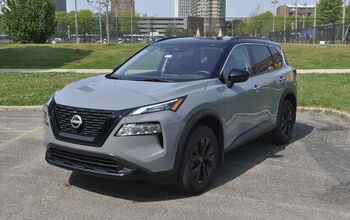2021 Dodge Charger and Challenger: Out With the New, In With the Old (Platform)?

When the first LX-platform Chryslers appeared in late 2004, buyers who had long grown wary of the automaker’s products took solace in the fact that the new 300 and Dodge Charger/Magnum borrowed so many components from bedmate Mercedes-Benz.
While not a direct carryover, the front and rear suspension, floorpan, and five-speed automatic transmission (among other items) all boasted German heritage. DaimlerChrysler found itself with a hit on its hands. Thirteen years later, after many updates and styling refreshes, LX cars still trundle off Fiat Chrysler’s Brampton, Ontario assembly line and into the waiting arms of North American traditionalists.
It was long expected that, after FCA hit snooze on a planned 2019 platform swap, we’d see new underpinnings for the old rear-drivers by 2021. Hold your horses, says CEO Sergio Marchionne.
The executive, who revealed the company’s new five-year plan on Friday (sans Chrysler, Dodge, and Fiat), suggests the future Dodge Charger and Challenger might stick with the current platform, albeit in heavily modified form.
Side note: the 300 is all but guaranteed to die, as per earlier remarks by Marchionne.
In the company’s last five-year plan, the LX cars were poised to gain Italian architecture for the 2019 model year, most likely the rear-drive Giorgio platform used by the Alfa Romeo Giulia. Last year, however, Automotive News reported that the Maserati Ghibli’s underpinnings would set up shop beneath the American full-sizers.
That’s a problem, as the Ghibli’s now expected to adopt the Giorgio platform towards the end of the automaker’s five-year planning window. In other words, right around the time the next-generation Dodges roll out of Brampton.
Comments reported by Motor Authority late Friday show FCA has second thoughts about the Giorgio platform.
“We may not necessarily have to go as far as the Giorgio architecture for Dodge as long as we are willing to commit to a significant upgrade to the current architecture to make it competitive,” said Marchionne. “That’s something that’s already started.”
He continued: “Certainly by the time we finish with that architecture, you will not recognize its origins. We may maintain its bare-bones structure.”
Marchionne implied that the Italian platform might not be the best fit for models boasting V8 engines of up to 707 horsepower. “The problem with Giorgio is from size and capability standpoint it reflects much more of a European performance requirement than it does the American heritage of Dodge,” he said.
Without giving a timeline for the revamped platform’s completion, we’re left assuming the 2021 date is still in play. Should FCA go this route, it means the next generation of cars could maintain the current generation’s generous proportions, though perhaps not their weight. A diet seems unavoidable. It’s necessary if FCA wants to offer, say, a turbocharged 2.0-liter four-cylinder with eTorque mild hybrid assist in the future lineup.
Let’s hope the engineers erase an Achilles Heel in the process. Meaning, of course, the Challenger’s dismal performance in the small overlap front crash test.
[Image: Fiat Chrysler Automobiles]

More by Steph Willems
Latest Car Reviews
Read moreLatest Product Reviews
Read moreRecent Comments
- Arthur Dailey We have a lease coming due in October and no intention of buying the vehicle when the lease is up.Trying to decide on a replacement vehicle our preferences are the Maverick, Subaru Forester and Mazda CX-5 or CX-30.Unfortunately both the Maverick and Subaru are thin on the ground. Would prefer a Maverick with the hybrid, but the wife has 2 'must haves' those being heated seats and blind spot monitoring. That requires a factory order on the Maverick bringing Canadian price in the mid $40k range, and a delivery time of TBD. For the Subaru it looks like we would have to go up 2 trim levels to get those and that also puts it into the mid $40k range.Therefore are contemplating take another 2 or 3 year lease. Hoping that vehicle supply and prices stabilize and purchasing a hybrid or electric when that lease expires. By then we will both be retired, so that vehicle could be a 'forever car'. Any recommendations would be welcomed.
- Eric Wait! They're moving? Mexico??!!
- GrumpyOldMan All modern road vehicles have tachometers in RPM X 1000. I've often wondered if that is a nanny-state regulation to prevent drivers from confusing it with the speedometer. If so, the Ford retro gauges would appear to be illegal.
- Theflyersfan Matthew...read my mind. Those old Probe digital gauges were the best 80s digital gauges out there! (Maybe the first C4 Corvettes would match it...and then the strange Subaru XT ones - OK, the 80s had some interesting digital clusters!) I understand the "why simulate real gauges instead of installing real ones?" argument and it makes sense. On the other hand, with the total onslaught of driver's aid and information now, these screens make sense as all of that info isn't crammed into a small digital cluster between the speedo and tach. If only automakers found a way to get over the fallen over Monolith stuck on the dash design motif. Ultra low effort there guys. And I would have loved to have seen a retro-Mustang, especially Fox body, have an engine that could rev out to 8,000 rpms! You'd likely be picking out metal fragments from pretty much everywhere all weekend long.
- Analoggrotto What the hell kind of news is this?


































Comments
Join the conversation
If only FCA had an existing sporting RWD sedan platform. *Looks at Alfa Romeo. *Looks at Maserati. Hmmm....
LX cars still trundle off Fiat Chrysler’s Brampton, Ontario assembly line" Uh no. 2006-2010, LX Charger 2011-Present, LD Charger 2008–2014, LC Challenger 2015-Present, LA Challenger